Lands of the Bohemian Crown
TheLands of the Bohemian Crownwere the states inCentral Europeduring themedievalandearly modern periodswithfeudalobligations to theBohemian kings.Thecrown landsprimarily consisted of theKingdom of Bohemia,anelectorateof theHoly Roman Empireaccording to theGolden Bull of 1356,theMargraviate of Moravia,theDuchies of Silesia,and the twoLusatias,known as the Margraviate of Upper Lusatia and the Margraviate of Lower Lusatia, as well as other territories throughout its history. This agglomeration of states nominally under the rule of the Bohemian kings was referred to simply asBohemia.[1]They are now sometimes referred to in scholarship as theCzech lands,a direct translation of the Czech abbreviated name.
The joint rule ofCorona regni Bohemiaewas legally established by decree ofKing Charles IVissued on 7 April 1348, on the foundation of the original Czech lands ruled by thePřemyslid dynastyuntil 1306. By linking the territories, the interconnection ofcrown landsthus no more belonged to a king or a dynasty but to the Bohemian monarchy itself, symbolized by theCrown of Saint Wenceslas.During the reign ofKing Ferdinand Ifrom 1526, the lands of the Bohemian Crown became a constituent part of theHabsburg monarchy.A large part of Silesia was lost in the mid-18th century, but the rest of the Lands passed to theAustrian Empireand theCisleithanianhalf ofAustria-Hungary.By theCzechoslovak declaration of independencein 1918, the remaining Czech lands became part of theFirst Czechoslovak Republic.
The Bohemian Crown was neither apersonal unionnor afederationof equal members. Rather, the Kingdom of Bohemia had a higher status than the other incorporated constituent countries. There were only some common state institutions of the Bohemian Crown that did not survive the centralization of theHabsburg monarchyunder QueenMaria Theresain the 18th century. The most important of them was theBohemian Court Chancellerywhich was united with the Austrian Chancellery in 1749.[2]
Name[edit]
TheLands of the Bohemian Crown(Latin:Corona regni Bohemiae, litCrown of the Kingdom of Bohemia) are calledzemě Koruny českéor simplyKoruna česká(Crown of BohemiaorBohemian Crown)[3][4][5]andČeské země(i.e.Czech lands), theCzechadjectivečeskýreferring to both "Bohemian"and"Czech".TheGermantermLänder der Böhmischen Kroneis likewise shortened toBöhmische KroneorBöhmische Kronländer.Native names includeSilesian:Korōna Czeskigo Krōlestwa,Lower Sorbian:zemje Českeje krony,andUpper Sorbian:kraje Čěskeje Króny.The denotationLands of the Crown of Saint Wenceslas(země Koruny svatováclavské) refers to theCrown of Saint Wenceslas,part of theregaliaof the Bohemian monarchs.
History[edit]
Přemyslids[edit]
In the 10th and 11th century, theDuchy of Bohemia,together withMoravia(theMargraviate of Moraviafrom 1182 on), andKłodzko Landwere consolidated under the rulingPřemyslid dynasty.
DukeOttokar I of Bohemiagained the hereditary royal title to the Duchy of Bohemia in 1198, from the German (anti)−kingPhilip of Swabia,for his support. Along with the title, Philip also raised the duchy to the Kingdom of Bohemia rank. The regality was ultimately confirmed by Philip's nephew theGerman KingFrederick II,later theHoly Roman Emperor(1220−1250), in theGolden Bull of Sicilyissued in 1212.
The Přemyslid kingOttokar II of Bohemiaacquired theDuchy of Austriain 1251, theDuchy of Styriain 1261, theEgerlandin 1266, theDuchy of Carinthiawith theMarch of Carniolaand theWindic Marchin 1269 as well as the March ofFriuliin 1272. His plans to turn Bohemia into the leadingImperial Statewere aborted by hisHabsburgrival KingRudolph I of Germany,who seized his acquisitions and finally defeated him in the 1278Battle on the Marchfeld.[2]
Luxembourgers[edit]
In 1306, theHouse of Luxembourgbegan producing Bohemian kings upon the extinction of the Přemyslids. They significantly enlarged the Bohemian lands again, including when KingJohn the Blindvassalized most PolishPiastdukes ofSilesia.His suzerainty was acknowledged by the Polish kingCasimir III the Greatin the 1335Treaty of Trentschin.John also achieved theenfeoffmentwith theUpper Lusatianlands ofBautzen(1319) andGörlitz(1329), by theGerman kingLouis IV.
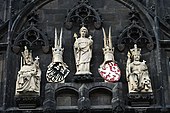
King John's eldest sonCharles IVwas electedKing of the Romansin 1346 and succeeded his father as King of Bohemia in the same year. In 1348, Charles IV introduced the concept of theCrown of Bohemia(Corona regni Bohemiaein Latin), a term which designated the whole state hereditarily ruled by the kings of Bohemia, not only its core territory of Bohemia but also the incorporated provinces.[6]
The Luxembourg dynasty reached its high point, when Charles was crownedHoly Roman Emperorin 1355.[2]By his Imperial authority he decreed that the united Bohemian lands should endure regardless of dynastic developments, even if the Luxembourgs should die out.[7]
In 1367, he purchasedLower Lusatiafrom his stepson MargraveOtto V of Brandenburgand theMargraviate of Brandenburg.Beside their homeCounty of Luxembourgitself, the dynasty held further non-contiguous Imperial fiefs in theLow Countries,such as: theDuchy of BrabantandDuchy of Limburg,acquired through marriage by Charles' younger half-brotherWenceslaus of Luxembourgin 1355; as well as theMargraviate of Brandenburgpurchased in 1373. As both the King of Bohemia and the Margrave of Brandenburg had been designatedPrince-electorsin theGolden Bull of 1356,the Luxembourgs held two votes in the electoral college, securing the succession of Charles's sonWenceslausin 1376.
With King Wenceslaus, the decline of the Luxembourg dynasty began. He himself was deposed as King of the Romans in 1400. The Duchies of Brabant, Limburg (in 1406), and even Luxembourg itself (in 1411) were ceded to the FrenchHouse of Valois-Burgundy;while the Margraviate of Brandenburg passed to theHouse of Hohenzollern(in 1415).[7]Nevertheless, the joint rule of the Bohemian Lands outlived theHussite Warsand the extinction of the Luxembourg male line upon the death of EmperorSigismundin 1437.
Jagiellons[edit]
Vladislas IIof theJagiellon dynasty,son of the Polish kingCasimir IV,was designated King of Bohemia in 1471, while the crown lands of Moravia, Silesia, and the Lusatias were occupied by rivaling KingMatthias Corvinusof Hungary. In 1479, both kings signed theTreaty of Olomouc,whereby the unity of the Bohemian crown lands was officially retained unchanged and the monarchs appointed each other as sole heir. Upon the death of King Matthias in 1490, Vladislas ruled the Bohemian crown lands and theKingdom of Hungaryin personal union.
Habsburgs[edit]
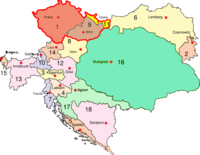
When Vladislas' only sonLouiswas killed at theBattle of Mohácsin 1526, ending the Jagiellon dynasty rule in Bohemia, a convention of Bohemian nobles elected his brother-in-law, theHabsburgarchdukeFerdinand I of Austria,as the new king of the Bohemian crown lands. Together with theArchduchy of Austria"hereditary lands" and theHungarian kingdom,they formed theHabsburg monarchy,which in the following centuries grew out of the Holy Roman Empire into a separate European power. Attempts by the BohemianProtestant Reformationestates to build up an autonomous confederation were dashed at the 1620Battle of White Mountain,whereafter the administration was centralised atVienna.Moreover, the Habsburg rulers lost the Lusatias to theElectorate of Saxonyafter theThirty Years' Warin the 1635Peace of Prague,and also most of Silesia with Kladsko to theKingdom of Prussiaafter theFirst Silesian Warin the 1742Treaty of Breslau.[2]
In the modern era, the remaining crown lands ofBohemia,MoraviaandAustrian Silesiabecame constituent parts of theAustrian Empirein 1804, and later theCisleithanianhalf ofAustria-Hungaryin 1867.
AfterWorld War Iand the dissolution of the Austro-Hungarian monarchy, these became the historic regions usually referred to as theCzech landsforming theCzech Republic.Austrian Silesia with theHlučín Regionis today known asCzech Silesia,with the exception of easternCieszyn Silesiawhich passed to theSecond Polish Republicin 1920.[7]
Bohemian territories[edit]
Crown lands[edit]
| Crown land | Type | Map | Capital or important city | Ethnic group | Religion | Notes |
|---|---|---|---|---|---|---|
| Kingdom | 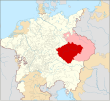
|
Prague | Bohemians (Czechs) Germans |
Roman Catholic Hussite(15th-17th centuries) Anabaptist(15th-17th centuries) Lutheran |
Royal dignity first bestowed uponVratislaus II of Bohemiain 1085, hereditary since 1198 under KingOttokar I;Electorateof theHoly Roman Empire,confirmed by theGolden Bull of 1356.Included the ImperialdomainofEgerland(Chebsko), obtained by KingWenceslaus IIbetween 1291–1305, definitely given in pawn to Bohemia by KingLouis IVin 1322 and subsequently ruled in personal union with Bohemia proper; as well as theCounty of Kladsko,established in 1459 and conquered by thePrussiankingFrederick the Greatin 1742. | |
| Margraviate | 
|
Olomouc, Brno |
Czechs(Moravians) Germans |
Roman Catholic Hussite(15th-17th centuries) Anabaptist(15th-17th centuries) Lutheran |
Principalities of Olomouc, Brno andZnojmo,acquired byPřemyslidandSlavníkBohemian rulers after the 955Battle of Lechfeld,lost in 999 toPolandand reconquered by DukeBretislaus Iin 1035. Elevated to a margraviate by the Přemyslid dukes in 1182, Bohemianfieffrom 1197. | |
| Duchies | 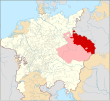
|
Wrocław | Germans Czechs/Bohemians Silesians Poles Moravians |
Roman Catholic Lutheran |
Many various duchies, acquired by the 1335Treaty of Trentschinbetween KingJohn of Bohemiaand KingCasimir III of Poland.The Habsburg queenMaria Theresalost Silesia in 1742 to thePrussiankingFrederick the Greatby theTreaty of Breslau,with the exception of its South-East part which became calledAustrian Silesia(laterCzech Silesia). Today divided between Poland, the Czech Republic, and Germany. | |
Upper Lusatia |
Margraviate | 
|
Bautzen | Germans Sorbs |
Roman Catholic Lutheran |
FormerMilcenilands ofMeissen,finally incorporated by KingJohn of Bohemiain 1319 (Bautzen) and 1329 (Görlitz). The Habsburg emperorFerdinand IIof Habsburg lost the Lusatias to theElectorate of Saxonywith the 1635Peace of Prague.Formally part of the Crown of Bohemia until 1815, today divided between Germany and Poland. |
Lower Lusatia |
Margraviate | 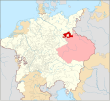
|
Lübben | Germans Sorbs |
Lutheran | FormerMarch of Lusatia,acquired by EmperorCharles IVfrom MargraveOtto V of Brandenburgin 1367. The Habsburg emperorFerdinand IIof Habsburg lost the Lusatias to theElectorate of Saxonywith the 1635Peace of Prague.Formally part of the Crown of Bohemia between until 1815, today divided between Germany and Poland. |
(Zgorzelec) |
Duchy | 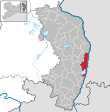
|
Görlitz | Germans Sorbs |
Roman Catholic | Duchy created by EmperorCharles IVfor his third sonJohn of Görlitz;he was the only Duke of Görlitz (Zgorzelec) from 1377 until his death. |
Other territories[edit]
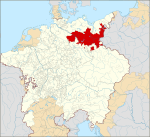
 TheBrandenburg Electorate,acquired by Charles IV from Margrave Otto V in 1373. Charles' sonSigismundgranted Brandenburg in 1415 toFrederick I, Elector of Brandenburg.
TheBrandenburg Electorate,acquired by Charles IV from Margrave Otto V in 1373. Charles' sonSigismundgranted Brandenburg in 1415 toFrederick I, Elector of Brandenburg. The adjacent northern part of theUpper Palatinate( "Bohemian Palatinate") atSulzbach,incorporated by Charles IV in 1355. Charles' sonWenceslauslost the area in 1401 to theElectorate of the PalatinateunderKing Ruprecht of Germany.
The adjacent northern part of theUpper Palatinate( "Bohemian Palatinate") atSulzbach,incorporated by Charles IV in 1355. Charles' sonWenceslauslost the area in 1401 to theElectorate of the PalatinateunderKing Ruprecht of Germany. Egerland
Egerland
Administrative divisions[edit]
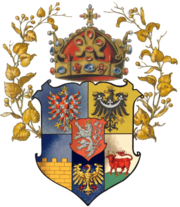
|
Kraje ofMargraviate of Moravia |
|
See also[edit]
| History of the Czech lands |
|---|
 |
|
|
- Czech lands
- History of the Czech lands
- List of rulers of Bohemia
- Lands of the Crown of Saint Stephen
- Crown of the Kingdom of Poland
- Crown of Aragon
- Crown of Castille
- Real union
References[edit]
- ^The Cambridge Modern History.The Macmillan Company. 1902. p. 331.
- ^abcdGeschichte der tschechischen öffentlichen Verwaltung Karel Schelle, Ilona Schelleová, GRIN Verlag, 2011(in German and Czech)
- ^"The Archives of the Crown of Bohemia".National Archive of the Czech Republic (Národní archiv ČR). Archived fromthe originalon 20 December 2009.Retrieved6 June2014.
- ^Teich, Mikuláš,ed. (1998).Bohemia in history(1. publ. ed.). Cambridge: Cambridge University Press. p. 117.ISBN0-521-43155-7.
- ^"Silesia – Pearl in the Crown of Bohemia".National Gallery in Prague (Národní galerie v Praze).Retrieved6 June2014.
- ^Šitler, Jiří (12 July 2016)."From Bohemia to Czechia".Radio Prague International.Czech Radio.Retrieved26 January2020.
- ^abcPrinz, Friedrich (1993).Deutsche Geschichte in Osten Europas: Böhmen und Mähren(in German). Berlin: Wolf Jobst Siedler Verlag GmbH. p. 381.ISBN3-88680-200-0.Retrieved25 February2013.
External links[edit]
- "Bohemia".BBC Radio 4 discussion with Norman Davies, Karin Friedrich and Robert Pynsent (In Our Time;April 11, 2002).



